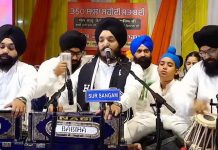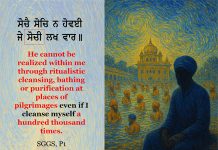
By Gurnam Singh and Manjit Kaur, UK | Opinion |
A recent incident in the UK at the Gurdwara Sahib in Leamington Spa and Warwick on Saturday, 26 July 2025, has reignited the ongoing debate surrounding mixed-faith Anand Karaj ceremonies within Sikh institutions. The case, involving a proposed marriage between a Sikh bride and a groom from a Khatri Brahmin (Hindu) background, ended in confusion, conflict and heartbreak for both families – as well as for the Gurdwara management – on what ought to have been a joyous and sacred occasion.
An unnamed source from the local community provided the following details of the day’s events.
The Incident Unfolds
On the morning of the planned Anand Karaj, three Sikh men were seen outside the Gurdwara premises expressing concerns and enquiring about the ceremony scheduled to take place later in Hall Number 3. Inside, approximately seven other individuals had already gathered with the apparent intention of preventing the Anand Karaj from going ahead. In fact, they had already removed the Guru Granth Sahib from the Palki Sahib and returned it to the Sach Khand room.
The group approached committee members and voiced their objections to the proposed ceremony. Fearing disruption, a committee member contacted both the General Secretary of the Gurdwara and the local police. The General Secretary, other members of the Gurdwara Management Committee and a Punjabi-speaking female police officer soon arrived to mediate.
As discussions unfolded, the group of ‘Sikh protesters’, who by now were in considerable numbers, declared they would not allow the wedding to proceed, arguing that Anand Karaj, as a sacred Sikh rite, should be reserved for practising Sikhs only.
Despite this intervention, the Milni (pre-marriage family introduction ceremony) had already taken place, and guests, having taken their morning breakfast, began to congregate Hall No 3. Committee members engaged in further dialogue with the protesters in the hope of finding a resolution. A compromise was proposed by the protesters that instead of the Anand Karaj, a modified religious blessing could take place.
After consulting with the bride, groom and families, and with the support of the police officer and Gurdwara General Secretary, an alternative programme was agreed upon. It included a recitation of Japji Sahib, selected Shabads, Anand Sahib and Ardas. The couple were permitted to sit respectfully together in the presence of Guru Granth Sahib Ji and participate in the service. Though visibly upset, both parties agreed to this revised arrangement.
A Mirror to a Wider Dilemma
This unfortunate episode serves as both a case study and a warning. While such incidents may be relatively rare, for those involved – be they families, guests, Gurdwara committee members or protesters – the distress caused is real and lasting. Moreover, these events risk undermining Sikhi and the very institutions that are meant to embody inclusion, dignity, unity and love.
Interfaith Marriages in Broader Religious Contexts
To be clear, this is not an issue unique to the Sikh community. All faith traditions face similar dilemmas.
In the Abrahamic traditions, interfaith marriages are generally approached with caution. Orthodox and Conservative branches of Judaism prohibit such unions unless the non-Jewish partner converts, while Reform and Reconstructionist movements tend to be more inclusive. In Christianity, Catholicism allows interfaith marriage with a bishop’s dispensation, and Eastern Orthodox churches typically disallow it unless the partner converts. Islam permits Muslim men to marry Christian or Jewish women but prohibits Muslim women from marrying non-Muslims unless the partner converts. The Baháʼí Faith, by contrast, places no barriers on interfaith marriage, instead emphasising mutual respect and spiritual unity.
Among the Indic traditions, attitudes vary. Hinduism traditionally discourages interfaith marriage due to caste and dharma considerations, though urban and modern contexts show greater acceptance. Buddhism tends to adopt a more flexible stance, prioritising individual spiritual development and mutual respect.
Within Sikhi, the official Sikh Rehat Maryada (Sikh Code of Conduct) reserves the Anand Karaj ceremony for two Sikhs. However, social attitudes, particularly among diasporic and younger generations, are far more varied, and many Gurdwaras across the world and most significantly in India, accommodate interfaith ceremonies without incident. Nevertheless, a lack of consensus continues to provoke tension, confusion and conflict, particularly in the UK.
Who Is a Sikh?
At the heart of this debate lies a profound and unresolved question: Who is a Sikh? According to the Sikh Rehat Maryada, a Sikh is someone who believes in the teachings of the Ten Gurus, accepts the authority of the Guru Granth Sahib, and aspires to live according to Sikh principles, ideally through Amrit initiation. Yet, in practice, this definition is difficult to enforce. In the Leamington case discussed earlier, for example, credible reports suggest the groom’s family, though of a Punjabi Khatri Hindu Brahmin background, were deeply connected to Sikh values and had long been associated with the Gurdwara.
If strict Amritdhari status were to be enforced, then the vast majority of Punjabi Sikhs marrying through Anand Karaj today would fall short. Many Gurdwaras do not question Sikh brides and grooms who appear culturally Sikh but may hold little spiritual connection to the faith or respect for maryada. Indeed, it is not uncommon for individuals to discard Sikh symbols, such as turbans, beards and tradition Panjabi attire, immediately after the ceremony. This exposes a troubling inconsistency where those who identity as Sikhs though family lineage are often privileged over those who may have genuine belief in the divine and indeed Sikh values, but are classified as non-Sikhs.
The Clash of Interpretations
Those who oppose mixed-faith Anand Karaj ceremonies cite the need to preserve the spiritual sanctity of the rite and to maintain communal boundaries. They argue that Anand Karaj is not simply a cultural event but a sacred vow between two committed Sikhs.
By contrast, advocates for inclusion point out that the essence of Anand Karaj, as revealed in the Guru Granth Sahib and indeed the 4 Lava (Prayers), which are read during the ceremony, lies in the union of two souls, guided by shared values of love, service, and devotion. If both individuals are committed to these ideals, must they be disqualified simply due to external identity?
In the absence of any clear mechanism to assess belief or commitment to Sikhi, two approaches present themselves:
- A Strict Interpretation: Limit Anand Karaj to Amritdhari Sikhs only. This offers clarity and doctrinal consistency, though it risks excluding many Sikhs who are non-initiated.
- A Broader Interpretation: Permit Anand Karaj where both partners express reverence for the Guru Granth Sahib and commitment to Sikh values, irrespective of their cultural. Ethnic or racial background. This would require a structured process, such as pre-marriage education or declarations of intent, to preserve the dignity of the ceremony.
Some Gurdwaras have opted for a middle ground by offering alternative blessings for mixed-faith couples. This was the path chosen in the Leamington and Warwick case, though done in an unplanned and hasty manner. While such solutions may not satisfy all, they can prevent conflict and allow families to experience grace rather than humiliation.
A Call for Wisdom, Empathy, and Reason
At present, what seems inconsistent, even unjust, is that Panjabi Sikh brides and grooms who have little regard for Sikh values or practice often receive little scrutiny, while non-Panjabi individuals from other traditions, who may live more ethically and closely aligned with Sikh principles, are barred from participating in Anand Karaj. Let us not forget, young people from Sikh backgrounds who fall in love with someone from a different heritage are not betraying the faith; they are reflecting the world they live in. To drive them away, or worse, humiliate them, will not safeguard Sikhi. It will only deepen the generational divide and hasten the community’s fragmentation.
Mixed heritage relationships are on the rise, driven by a complex web of social, educational and economic factors. The challenge before us is not to police love, but to uphold the spiritual dignity of our institutions while also showing compassion and understanding. There are no easy answers, but silence, inconsistency, or hostility are no longer viable options; we must find a solution that is not hypocritical and in conflict with the deep spiritual message of Sikhi.

About the Authors:
Gurnam Singh is an academic. Manjit Kaur is a journalist, professional counsellor and group therapist. Both are based in the UK and focus on issues affecting Sikh communities in the diaspora. They are regular columnists for Asia Samachar.
* This is the opinion of the writer and does not necessarily represent the views of Asia Samachar.
RELATED STORY:
The Demise of the Akali Dal and the Badal Dynasty: What Next for the Panth? (Asia Samachar, 5 Aug 2024)
ASIA SAMACHAR is an online newspaper for Sikhs / Punjabis in Southeast Asia and beyond. You can leave your comments at our website, Facebook, Twitter, and Instagram. We will delete comments we deem offensive or potentially libelous. You can reach us via WhatsApp +6017-335-1399 or email: asia.samachar@gmail.com. For obituary announcements, click here































